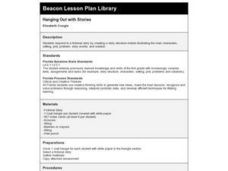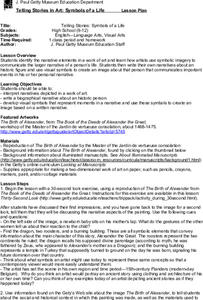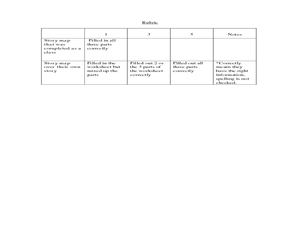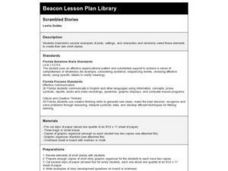Teacherfiles
Plot Graph
Any story can be mapped onto a plot graph. This particular chart includes the mountain shape of a traditional plot graph. Each element of plot is labeled on the page and surrounded by a box to make the words stand out. Learners write in...
Curated OER
Hanging Out with Stories
Help your class listen and respond to a fictional story by creating a story structure mobile illustrating the main characters, setting, plot, problem, story events, and solution. Using a coat hanger, they will create an artistic element...
Curated OER
Interpreting Characters, Setting, Plot, and Theme - The Triangle Shirtwaist Factory Disaster
Examine story development and historical disaster with your class. Learners view a video depicting the incidents surrounding The Triangle Shirtwaist Disaster. They use graphic organizers and the Internet to gather enough information to...
Curated OER
Telling Stories in Art: Symbols of a Life
Through a series of activities, learners are exposed to how artists use symbolic imagery to create the narrative of a subject’s life. They study The Birth of Alexander and some manuscripts kept at J. Paul Getty Museum. They then draft...
Curated OER
Story Stew
Young scholars identify the elements of a story. In this reading and writing lesson, pupils read the book, Tyrone the Horrible by Hans Wihelm and then identify the characters, setting, and plot of the story.This lesson includes...
Core Knowledge Foundation
Stories Tell It Again!™ Read-Aloud Anthology
An anthology created for kindergarteners explores classic stories that have been told for generations. Young scholars listen to 10 read-alouds, answer reading comprehension questions, and practice a skill related to the text. Stories...
Pinecrest Preparatory Middle and High School
Short Story Planning Guide
A short story is only as strong as its characters, development, and conflicts. Encourage the young authors in your class to plan their stories based on the elements of narrative writing, all provided in brainstorming graphic organizers.
Curated OER
The Learning Network: Re-envisioning Classic Stories
Readers reflect on enjoyable stories they know, brainstorm criteria that make a story "good," analyze a New York Times article about innovative children's performances, re-envision classics on their own, and peer edit drafts. Use this as...
Curated OER
Noisy Nora, Studious Students: Story Elements
Alliterative adjective nicknames generate stories inspired by Rosemary Wells' book Noisy Nora (also a thematic complement to any class with children who make a ruckus to get attention). Class members explore basic story elements --...
Curated OER
Story Elements that Support the Theme
Three great graphic organizers guide readers to see how the elements of plot and main idea can be charted to reveal the theme of a story. Model the process on the provided Direct Teaching Teacher Graphic Organizer using Aesop’s The...
Curated OER
Which Story Matches the Given Theme?
Model for young learners how to determine the theme of a story. Read aloud Aesop’s The Fox and the Stork. Chart the plot and the main idea of the fable, showing class members how these elements support the theme. Fable titles for guided...
Curated OER
Illustrating the Elements of a Story
Explore the elements of a story with this two-page graphic organizer. Readers write and draw descriptions of each element, including setting, plot, conflict, rising action, climax, dialogue, and narration.
Curated OER
Genre: Short Story
Discover the genre of short stories with sixth graders. They discuss the characteristics of short stories from the book America Street. Then, they compare and contrast movies and television shows and chart story characteristics. Various...
Teacher's Corner
Dr. Seuss Story Map
Guide young readers through their first book report with a story map designed for a Dr. Seuss book. After your class finishes their story of choice, they list the title, characters, conflict, and other elements of literature on the book...
Curated OER
Cinderella Folk Tales: Variations in Plot and Setting
Young scholars examine plot and setting of Cinderella, and how it changes as it is translated into different cultures, discuss universal literary elements of the Cinderella story, and write narratives with original settings and plots...
K12 Reader
Tell the Story - The Cows Go Shopping
Will Casey get a can of clover? After examining the provided writing prompt about Casey's trip to the grocery store, young writers must decide what happens next and tell their story with words and pictures.
Curated OER
Frame Story "The Celebrated Jumping Frog of Calaveras County"
Mark Twain's frame story, "The Celebrated Jumping Frog of Calaveras County" provides an opportunity for a study of this story-within-a-story pattern. Using an illustrated template, class members record a plot summary of the frame story...
Curated OER
Create - A - Story
Apply the elements of a story to create an original story. They select a character, setting, and plot out of a bag, and write an original story tying the three story elements together.
Curated OER
Scrambled Stories
Character development, setting, and plot? Sounds like the makings of a good narrative story. Young authors read and analyze several narrative examples, and then they use what they know to pen an original composition. They work both in...
Core Knowledge Foundation
Fables and Stories Tell It Again!™ Read-Aloud Anthology
A read-aloud anthology focuses on fables. Over three weeks, first graders listen to various stories and then participate in lessons that cover story elements, including plot, characters, setting, and personification and explore...
Curated OER
Story Elements
Review story elements with your class using this resource. Learners can take a story they have read as a class and identify story elements. They focus on characters, setting, the introduction, and plot. Then, they use graphic organizers...
Curated OER
Story Plan Graphic Organizer
In this story planner graphic organizer worksheet, pupils fill in the genre, characters, setting, plot, complication and resolution before they use the information to write a story. They also list useful words that will be used.
Vanier College
Analyzing Short Stories/Novels
Good questions can help focus readers' attention on the elements writers use to add depth to their stories. The questions on this worksheet do just that and encourage readers to think critically about a story and author's purpose.
Curated OER
Parts of the Plot: Constructing A Plot Diagram
After reading "The King of Mazy May" by Jack London, learners reinforce their literary analysis skills in this SMART board lesson. The provided SMART board file allows themto define elements of a short story, and then add it to the plot...
Other popular searches
- Plot Story Structure
- Story Elements Plot Chart
- Identify the Plot of a Story
- Plot Story Element
- Plot Retelling Story Events
- Story Elements Plot
- Understand the Plot in a Story
- Plot/story Line
- The Plot of a Story
- Story Theme Plot Setting
- Short Story and Plot Graph
- Plot Story Development

























